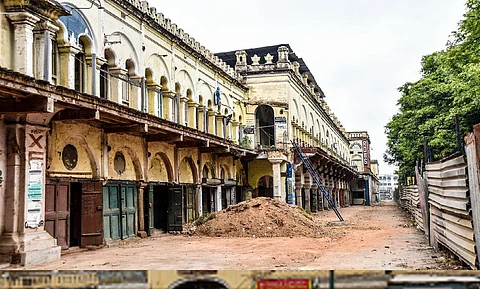

New Delhi | Conservation architects and other domain experts have pitched for preserving a late 19th century market in Mysuru and called for carrying out development projects while remaining "sensitive to the built heritage" of the city in Karnataka.
The historic Devaraja Market, constructed in the heart of the city in the 1880s by the Mysore royals, is facing an uncertain future for many years and marked for demolition for a redevelopment project, according to INTACH Bengaluru Chapter.
Seeking to highlight its architectural and historical value and to emphasise on preservation of historical markets, a series of events -- a symposium, a heritage walk and urban sketching -- was held in Mysuru on Saturday.
Hailed as a 'heritage city', Mysuru is dotted with iconic buildings largely constructed by the Wadiyars -- the royal family of the erstwhile Mysore State, including the Mysore royal palace, Lalitha Mahal Palace, old railway station, Mysore University building, and many other iconic landmarks.
During the symposium hosted by the Bengaluru Chapter of the Delhi-based Indian National Trust for Art and Cultural Heritage (INTACH) at the Wadiyar Centre for Architecture (WCFA), the current scion of the royal family, Yaduveer Krishnadatta Chamaraja Wadiyar eloquently made a case for preserving the Devaraja Market, built by his ancestors.
Conservation of this market and other heritage buildings in Mysuru are integral to the identity of the city, he asserted in a virtual address at the event, according to a statement issued by INTACH Bengaluru Chapter.
Wadiyar, a graduate of the University of Massachusetts, the US, also suggested that "restoration" is important from the point of view of sustainability.
Preserving and reinvigorating built heritage is important so that the legacy can be passed to future generations, he had told PTI in 2018 and also advocated for preserving the built heritage of Bengaluru.
Other experts, including a structure engineer from Pune, concurred during the symposium that the Devaraja Market is a city icon, and "can be restored" and form a "nucleus" for insensitive development of Mysuru.
The theme of the discussion was 'Markets as Living Heritage: The Case for Conservation and Revival'.
Sanghamitra Basu, a conservation architect who recently retired as a faculty from IIT, Kharagpur, said, "Conservation is not (an act of) mummification," adding that amenities could be added to old structures with due sensitivity to the architectural fabric.
She shared the example of the restoration of Byward Market in Ottawa, Canada, which was to be demolished but when restored, it became one of the city's major centres for both tourists and local economic activities.
"It is important to have a management plan," she was quoted as saying in the statement.
Gurugram-based conservation architect Shikha Jain, who has worked on heritage-led development projects around the country, joined the event virtually.
"The economy of Jaipur depends on the cultural heritage which sits in the core of the city," she said.
Accordingly, the government agreed to restore these traditional markets which are now active, dynamic economic centres in Jaipur city, Jain added.
S Raghunath of BMS College of Engineering in Bengaluru shared examples where he has helped restore buildings that suffered "Grade 4-level damage", including Dr S Radhakrishnan's house in Mysuru and the Octroi post in Bengaluru.
"Devaraja Market has Grade 2-level of damage," he said, and asserted that it can be restored.
Pune-based Ranjit Patil, who has over four decades of experience as a structural engineer, also said the building "can be restored".
He suggested that the restoration could be funded through a CSR (corporate social responsibility) activity.
A joint statement was presented to the deputy commissioner of Mysuru after the conference which highlighted the feasibility of restoration and the central importance of traditional markets like Devaraja Market to the image of Mysuru as a heritage city, the statement said.
Bengaluru-based architect Yashaswini Sharma said the unique architectural features along with artisanal and material heritage of Devaraja Market as also of Lansdowne Building (built in 1890s), "cannot be replaced, and the significance of these buildings in the historical landscape of the core area of Mysuru cannot be undermined".
Even the idea of "reconstructing in same 'heritage' style" after demolishing the original building is "ironical, especially when the original is salvageable", Sharma said.
"One cannot reconstruct 'heritage'," she added.
